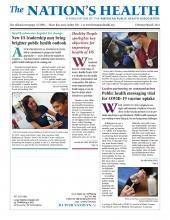
Briefs from the Council on Education for Public Health show changes in public health education between 2017 and 2019.
Photo by Fizkes, courtesy iStockphoto
Just a handful of years after the release of new accreditation standards for public health education, many schools have revamped their curricula, with a goal of graduating students ready to practice on day one.
A series of new briefs from the Council on Education for Public Health, released in November, shares information from hundreds of schools and programs, documenting changes in public health education between 2017 and 2019. In 2016, CEPH, which accredits schools and programs of public health, adopted revised accreditation criteria that shifted the focus from following a core curriculum to teaching core competencies.
Under the old criteria, public health curricula was built around five core areas: biostatistics, epidemiology, health services administration, social and behavioral science, and environmental health. Under the revised criteria, schools and programs can forgo the typical five-course model and teach the topics in any combination of ways, as long as students can demonstrate a set of nearly two-dozen competencies by graduation.
Alisha O’Connell, MPH, CEPH’s associate director for monitoring and evaluation, said the 16 stand-alone briefs, known as Trends 2020, not only highlight changes ushered in by the new accreditation criteria; they also provide the first “landscape view” on the current state of public health education.
“If the pandemic has taught us anything, it’s that we have to be agile,” O’Connell told The Nation’s Health. “The new (accreditation) framework sets up students to be able to step in and engage right away in the field and contribute.”
“The new (accreditation) framework sets up students to be able to step in and engage right away in the field and contribute.”
— Alisha O’Connell
The Trends 2020 briefs cover a range of topics, such as MPH and DrPH curriculum design, core areas of concentration, applied practice experiences and environmental health trends. O’Connell said the research showed that most schools and programs are shifting their curricula in “more flexible and creative ways” to meet the new competency criteria. For example, the brief on MPH curriculum design, which includes information on 184 MPH curricula from 180 accredited units, shows that 79% of MPH programs kept three to five core-area courses, but added in some new ones as well. Ten percent kept their curricula exactly the same, and the remainder diverged from the old core-area model to combine multiple public health disciplines and competencies in each course.
“Part of why the criteria was rewritten is that we wanted to allow (schools and programs) to be more adaptable and give them the space to be more innovative,” O’Connell said. “And I think we saw a lot of places take advantage of that.”
Among the biggest lessons gleaned from the research, O’Connell said, is that the revised accreditation criteria are fostering curricula focused on equipping students with practice-ready skills. For example, she said a number of MPH programs added new skill-based courses, such as classes on program planning, implementation and evaluation. Over half of MPH units studied added a research methods course as well.
CEPH released a Trends 2020 brief solely on environmental health trends, addressing concerns that the discipline might lose its curricular footing, as it was not directly represented in the revised 2016 accreditation criteria. Researchers found that as of December 2019, 91% of public health schools continued to offer an MPH in environmental health sciences and 94% offered at least one environmental health sciences degree. Before the revised criteria, all 59 accredited schools of public health offered an MPH concentration in environmental health sciences.
“Our main goal is to establish a baseline of what’s happening in public health education,” O’Connell said. “But we hope schools and programs will use (the briefs) to compare themselves to their peers and jump-start new ideas.”
For more information on the Trends 2020 briefs, visit http://ceph.org/trends2020.
- Copyright The Nation’s Health, American Public Health Association









